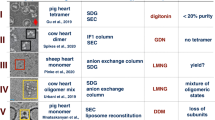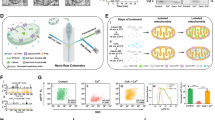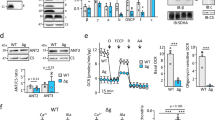Abstract
Lethal mitochondrial membrane permeabilization has been depicted as the result of two fundamentally distinct processes, namely primary mitochondrial outer membrane permeabilization (MOMP) versus permeability transition (PT) ignited at the level of the mitochondrial inner membrane. MOMP and PT have been connected to apoptosis and necrosis, respectively. Moreover, it has been thought that MOMP was mediated by pro-apoptotic multidomain proteins of the Bcl-2 family (Bax and Bak), which would operate near-to-independently from the permeability transition pore complex (PTPC) composed by voltage-dependent anion channel (VDAC), adenine nucleotide translocase (ANT) and cyclophilin D. A recent paper in Molecular and Cellular Biology now reveals the obligate contribution of one particular ANT isoform to the execution of developmental and homeostatic cell death in Caenorhabditis elegans. The physical and functional interaction between CED-9, the sole multidomain Bcl-2 protein of C. elegans, and ANT emphasizes the existence of an intricate, phylogenetically conserved crosstalk between Bcl-2 family proteins and constituents of the PTPC. In this issue of Cell Death and Differentiation, Malorni et al. further corroborate this notion by showing that type 2 transglutaminase (TG2) is essential for the correct assembly/function of ANT1, and that, at least in some experimental settings, TG2 might be required to enable and/or stabilize the pro-apoptotic association of Bax with ANT1.
Similar content being viewed by others
Log in or create a free account to read this content
Gain free access to this article, as well as selected content from this journal and more on nature.com
or
Abbreviations
- AAC:
-
ATP/ADP carrier
- AIF:
-
apoptosis-inducing factor
- ANT:
-
adenine nucleotide translocase
- ANT2BP:
-
ANT2-binding protein
- BH3:
-
Bcl-2 homology domain 3
- Δψm:
-
mitochondrial transmembrane potential
- DDG:
-
deoxy-D-glucose
- DRP-1:
-
dynamin-related protein-1
- MCP:
-
mitochondrial carrier protein
- mitoKATP:
-
mitochondrial ATP-sensitive K+ channel
- MMP:
-
mitochondrial membrane permeabilization
- MOMP:
-
mitochondrial outer membrane permeabilization
- MTCH:
-
mitochondrial carrier homolog
- PCD:
-
programmed cell death
- PS:
-
phosphatidylserine
- PT:
-
permeability transition
- PTPC:
-
permeability transition pore complex
- ROS:
-
reactive oxygen species
- STS:
-
staurosporine
- TG2:
-
type 2 transglutaminase
- VDAC:
-
voltage-dependent anion channel
References
Horvitz HR . Nobel lecture. Worms, life and death. Biosci Rep 2003; 23: 239–303.
Zermati Y, Mouhamad S, Stergiou L, Besse B, Galluzzi L, Boehrer S et al. Nonapoptotic role for Apaf-1 in the DNA damage checkpoint. Mol Cell 2007; 28: 624–637.
Shen Q, Qin F, Gao Z, Cui J, Xiao H, Xu Z et al. Adenine nucleotide translocator cooperates with core cell death machinery to promote apoptosis in C. elegans. Mol Cell Biol 2009; 29: 3881–3893.
Hu Y, Benedict MA, Wu D, Inohara N, Nunez G . Bcl-XL interacts with Apaf-1 and inhibits Apaf-1-dependent caspase-9 activation. Proc Natl Acad Sci USA 1998; 95: 4386–4391.
Pan G, O'Rourke K, Dixit VM . Caspase-9, Bcl-XL, and Apaf-1 form a ternary complex. J Biol Chem 1998; 273: 5841–5845.
Moriishi K, Huang DC, Cory S, Adams JM . Bcl-2 family members do not inhibit apoptosis by binding the caspase activator Apaf-1. Proc Natl Acad Sci USA 1999; 96: 9683–9688.
Haraguchi M, Torii S, Matsuzawa S, Xie Z, Kitada S, Krajewski S et al. Apoptotic protease activating factor 1 (Apaf-1)-independent cell death suppression by Bcl-2. J Exp Med 2000; 191: 1709–1720.
Hausmann G, O'Reilly LA, van Driel R, Beaumont JG, Strasser A, Adams JM et al. Pro-apoptotic apoptosis protease-activating factor 1 (Apaf-1) has a cytoplasmic localization distinct from Bcl-2 or Bcl-x(L). J Cell Biol 2000; 149: 623–634.
Maiuri MC, Le Toumelin G, Criollo A, Rain JC, Gautier F, Juin P et al. Functional and physical interaction between Bcl-X(L) and a BH3-like domain in Beclin-1. EMBO J 2007; 26: 2527–2539.
Li J, Yuan J . Caspases in apoptosis and beyond. Oncogene 2008; 27: 6194–6206.
Adams JM, Cory S . Life-or-death decisions by the Bcl-2 protein family. Trends Biochem Sci 2001; 26: 61–66.
Ekert PG, Vaux DL . The mitochondrial death squad: hardened killers or innocent bystanders? Curr Opin Cell Biol 2005; 17: 626–630.
Zou H, Henzel WJ, Liu X, Lutschg A, Wang X . Apaf-1, a human protein homologous to C. elegans CED-4, participates in cytochrome c-dependent activation of caspase-3. Cell 1997; 90: 405–413.
Oberst A, Bender C, Green DR . Living with death: the evolution of the mitochondrial pathway of apoptosis in animals. Cell Death Differ 2008; 15: 1139–1146.
Kroemer G . Mitochondrial implication in apoptosis. Towards an endosymbiont hypothesis of apoptosis evolution. Cell Death Differ 1997; 4: 443–456.
Galluzzi L, Joza N, Tasdemir E, Maiuri MC, Hengartner M, Abrams JM et al. No death without life: vital functions of apoptotic effectors. Cell Death Differ 2008; 15: 1113–1123.
Susin SA, Lorenzo HK, Zamzami N, Marzo I, Snow BE, Brothers GM et al. Molecular characterization of mitochondrial apoptosis-inducing factor. Nature 1999; 397: 441–446.
Wang X, Yang C, Chai J, Shi Y, Xue D . Mechanisms of AIF-mediated apoptotic DNA degradation in Caenorhabditis elegans. Science 2002; 298: 1587–1592.
Wang X, Wang J, Gengyo-Ando K, Gu L, Sun CL, Yang C et al. C. elegans mitochondrial factor WAH-1 promotes phosphatidylserine externalization in apoptotic cells through phospholipid scramblase SCRM-1. Nat Cell Biol 2007; 9: 541–549.
Wissing S, Ludovico P, Herker E, Buttner S, Engelhardt SM, Decker T et al. An AIF orthologue regulates apoptosis in yeast. J Cell Biol 2004; 166: 969–974.
Kroemer G, Galluzzi L, Brenner C . Mitochondrial membrane permeabilization in cell death. Physiol Rev 2007; 87: 99–163.
Orrenius S, Zhivotovsky B . Cardiolipin oxidation sets cytochrome c free. Nat Chem Biol 2005; 1: 188–189.
Ott M, Robertson JD, Gogvadze V, Zhivotovsky B, Orrenius S . Cytochrome c release from mitochondria proceeds by a two-step process. Proc Natl Acad Sci USA 2002; 99: 1259–1263.
Jagasia R, Grote P, Westermann B, Conradt B . DRP-1-mediated mitochondrial fragmentation during EGL-1-induced cell death in C. elegans. Nature 2005; 433: 754–760.
Delivani P, Adrain C, Taylor RC, Duriez PJ, Martin SJ . Role for CED-9 and Egl-1 as regulators of mitochondrial fission and fusion dynamics. Mol Cell 2006; 21: 761–773.
Breckenridge DG, Kang BH, Kokel D, Mitani S, Staehelin LA, Xue D . Caenorhabditis elegans drp-1 and fis-2 regulate distinct cell-death execution pathways downstream of ced-3 and independent of ced-9. Mol Cell 2008; 31: 586–597.
Breckenridge DG, Kang BH, Xue D . Bcl-2 proteins EGL-1 and CED-9 do not regulate mitochondrial fission or fusion in Caenorhabditis elegans. Curr Biol 2009; 19: 768–773.
Sheridan C, Delivani P, Cullen SP, Martin SJ . Bax- or Bak-induced mitochondrial fission can be uncoupled from cytochrome C release. Mol Cell 2008; 31: 570–585.
James DI, Martinou JC . Mitochondrial dynamics and apoptosis: a painful separation. Dev Cell 2008; 15: 341–343.
Vieira HL, Haouzi D, El Hamel C, Jacotot E, Belzacq AS, Brenner C et al. Permeabilization of the mitochondrial inner membrane during apoptosis: impact of the adenine nucleotide translocator. Cell Death Differ 2000; 7: 1146–1154.
Bernardi P, Forte M . The mitochondrial permeability transition pore. Novartis Found Symp 2007; 287: 157–164; discussion 164–159.
Zamzami N, Marchetti P, Castedo M, Decaudin D, Macho A, Hirsch T et al. Sequential reduction of mitochondrial transmembrane potential and generation of reactive oxygen species in early programmed cell death. J Exp Med 1995; 182: 367–377.
Marchetti P, Castedo M, Susin SA, Zamzami N, Hirsch T, Macho A et al. Mitochondrial permeability transition is a central coordinating event of apoptosis. J Exp Med 1996; 184: 1155–1160.
Zamzami N, Susin SA, Marchetti P, Hirsch T, Gomez-Monterrey I, Castedo M et al. Mitochondrial control of nuclear apoptosis. J Exp Med 1996; 183: 1533–1544.
Marzo I, Brenner C, Zamzami N, Jurgensmeier JM, Susin SA, Vieira HL et al. Bax and adenine nucleotide translocator cooperate in the mitochondrial control of apoptosis. Science 1998; 281: 2027–2031.
Belzacq AS, Vieira HL, Verrier F, Vandecasteele G, Cohen I, Prevost MC et al. Bcl-2 and Bax modulate adenine nucleotide translocase activity. Cancer Res 2003; 63: 541–546.
Jacotot E, Ferri KF, El Hamel C, Brenner C, Druillennec S, Hoebeke J et al. Control of mitochondrial membrane permeabilization by adenine nucleotide translocator interacting with HIV-1 viral protein rR and Bcl-2. J Exp Med 2001; 193: 509–519.
Pereira C, Camougrand N, Manon S, Sousa MJ, Corte-Real M . ADP/ATP carrier is required for mitochondrial outer membrane permeabilization and cytochrome c release in yeast apoptosis. Mol Microbiol 2007; 66: 571–582.
Buttner S, Eisenberg T, Carmona-Gutierrez D, Ruli D, Knauer H, Ruckenstuhl C et al. Endonuclease G regulates budding yeast life and death. Mol Cell 2007; 25: 233–246.
Palmieri L, Runswick MJ, Fiermonte G, Walker JE, Palmieri F . Yeast mitochondrial carriers: bacterial expression, biochemical identification and metabolic significance. J Bioenerg Biomembr 2000; 32: 67–77.
Zamora M, Granell M, Mampel T, Vinas O . Adenine nucleotide translocase 3 (ANT3) overexpression induces apoptosis in cultured cells. FEBS Lett 2004; 563: 155–160.
Bauer MK, Schubert A, Rocks O, Grimm S . Adenine nucleotide translocase-1, a component of the permeability transition pore, can dominantly induce apoptosis. J Cell Biol 1999; 147: 1493–1502.
Le Bras M, Borgne-Sanchez A, Touat Z, El Dein OS, Deniaud A, Maillier E et al. Chemosensitization by knockdown of adenine nucleotide translocase-2. Cancer Res 2006; 66: 9143–9152.
Kashiwaya K, Hosokawa M, Eguchi H, Ohigashi H, Ishikawa O, Shinomura Y et al. Identification of C2orf18, termed ANT2BP (ANT2-binding protein), as one of the key molecules involved in pancreatic carcinogenesis. Cancer Sci 2009; 100: 457–464.
Tajeddine N, Galluzzi L, Kepp O, Hangen E, Morselli E, Senovilla L et al. Hierarchical involvement of Bak, VDAC1 and Bax in cisplatin-induced cell death. Oncogene 2008; 27: 4221–4232.
Yang Z, Cheng W, Hong L, Chen W, Wang Y, Lin S et al. Adenine nucleotide (ADP/ATP) translocase 3 participates in the tumor necrosis factor induced apoptosis of MCF-7 cells. Mol Biol Cell 2007; 18: 4681–4689.
Brower JV, Rodic N, Seki T, Jorgensen M, Fliess N, Yachnis AT et al. Evolutionarily conserved mammalian adenine nucleotide translocase 4 is essential for spermatogenesis. J Biol Chem 2007; 282: 29658–29666.
Kehoe SM, Oka M, Hankowski KE, Reichert N, Garcia S, McCarrey JR et al. A conserved E2F6-binding element in murine meiosis-specific gene promoters. Biol Reprod 2008; 79: 921–930.
Poncet D, Pauleau AL, Szabadkai G, Vozza A, Scholz SR, Le Bras M et al. Cytopathic effects of the cytomegalovirus-encoded apoptosis inhibitory protein vMIA. J Cell Biol 2006; 174: 985–996.
Alcala S, Klee M, Fernandez J, Fleischer A, Pimentel-Muinos FX . A high-throughput screening for mammalian cell death effectors identifies the mitochondrial phosphate carrier as a regulator of cytochrome c release. Oncogene 2008; 27: 44–54.
Marzo I, Brenner C, Zamzami N, Susin SA, Beutner G, Brdiczka D et al. The permeability transition pore complex: a target for apoptosis regulation by caspases and bcl-2-related proteins. J Exp Med 1998; 187: 1261–1271.
Costantini P, Belzacq AS, Vieira HL, Larochette N, de Pablo MA, Zamzami N et al. Oxidation of a critical thiol residue of the adenine nucleotide translocator enforces Bcl-2-independent permeability transition pore opening and apoptosis. Oncogene 2000; 19: 307–314.
Vieira HL, Belzacq AS, Haouzi D, Bernassola F, Cohen I, Jacotot E et al. The adenine nucleotide translocator: a target of nitric oxide, peroxynitrite, and 4-hydroxynonenal. Oncogene 2001; 20: 4305–4316.
Belzacq AS, El Hamel C, Vieira HL, Cohen I, Haouzi D, Metivier D et al. Adenine nucleotide translocator mediates the mitochondrial membrane permeabilization induced by lonidamine, arsenite and CD437. Oncogene 2001; 20: 7579–7587.
Baines CP, Molkentin JD . Adenine nucleotide translocase-1 induces cardiomyocyte death through upregulation of the pro-apoptotic protein Bax. J Mol Cell Cardiol 2009; 46: 969–977.
Graham BH, Waymire KG, Cottrell B, Trounce IA, MacGregor GR, Wallace DC . A mouse model for mitochondrial myopathy and cardiomyopathy resulting from a deficiency in the heart/muscle isoform of the adenine nucleotide translocator. Nat Genet 1997; 16: 226–234.
Lee J, Schriner SE, Wallace DC . Adenine nucleotide translocator 1 deficiency increases resistance of mouse brain and neurons to excitotoxic insults. Biochim Biophys Acta 2009; 1787: 364–370.
Kokoszka JE, Waymire KG, Levy SE, Sligh JE, Cai J, Jones DP et al. The ADP/ATP translocator is not essential for the mitochondrial permeability transition pore. Nature 2004; 427: 461–465.
Malorni W, Farrace MG, Matarrese P, Tinari A, Ciarlo L, Mousavi-Shafae P et al. The adenine nucleotide translocator 1 acts as a type 2 transglutaminase substrate: implications for mitochondrial-dependent apoptosis. Cell Death Differ 2009.
Verrier F, Deniaud A, Lebras M, Metivier D, Kroemer G, Mignotte B et al. Dynamic evolution of the adenine nucleotide translocase interactome during chemotherapy-induced apoptosis. Oncogene 2004; 23: 8049–8064.
Green DR, Reed JC . Mitochondria and apoptosis. Science 1998; 281: 1309–1312.
Gogvadze V, Orrenius S, Zhivotovsky B . Multiple pathways of cytochrome c release from mitochondria in apoptosis. Biochim Biophys Acta 2006; 1757: 639–647.
Galluzzi L, Kroemer G . Necroptosis: a specialized pathway of programmed necrosis. Cell 2008; 135: 1161–1163.
Tsujimoto Y, Shimizu S . Role of the mitochondrial membrane permeability transition in cell death. Apoptosis 2007; 12: 835–840.
Eliseev RA, Malecki J, Lester T, Zhang Y, Humphrey J, Gunter TE . Cyclophilin D interacts with Bcl2 and exerts an anti-apoptotic effect. J Biol Chem 2009; 284: 9692–9699.
Schubert A, Grimm S . Cyclophilin D, a component of the permeability transition-pore, is an apoptosis repressor. Cancer Res 2004; 64: 85–93.
Brenner C, Cadiou H, Vieira HL, Zamzami N, Marzo I, Xie Z et al. Bcl-2 and Bax regulate the channel activity of the mitochondrial adenine nucleotide translocator. Oncogene 2000; 19: 329–336.
Hiller S, Garces RG, Malia TJ, Orekhov VY, Colombini M, Wagner G . Solution structure of the integral human membrane protein VDAC-1 in detergent micelles. Science 2008; 321: 1206–1210.
Scorrano L, Ashiya M, Buttle K, Weiler S, Oakes SA, Mannella CA et al. A distinct pathway remodels mitochondrial cristae and mobilizes cytochrome c during apoptosis. Dev Cell 2002; 2: 55–67.
Zamzami N, El Hamel C, Maisse C, Brenner C, Munoz-Pinedo C, Belzacq AS et al. Bid acts on the permeability transition pore complex to induce apoptosis. Oncogene 2000; 19: 6342–6350.
Roy SS, Madesh M, Davies E, Antonsson B, Danial N, Hajnoczky G . Bad targets the permeability transition pore independent of Bax or Bak to switch between Ca2+-dependent cell survival and death. Mol Cell 2009; 33: 377–388.
Claypool SM, Oktay Y, Boontheung P, Loo JA, Koehler CM . Cardiolipin defines the interactome of the major ADP/ATP carrier protein of the mitochondrial inner membrane. J Cell Biol 2008; 182: 937–950.
Dienhart MK, Stuart RA . The yeast Aac2 protein exists in physical association with the cytochrome bc1-COX supercomplex and the TIM23 machinery. Mol Biol Cell 2008; 19: 3934–3943.
Ardehali H, Chen Z, Ko Y, Mejia-Alvarez R, Marban E . Multiprotein complex containing succinate dehydrogenase confers mitochondrial ATP-sensitive K+ channel activity. Proc Natl Acad Sci USA 2004; 101: 11880–11885.
Ott M, Norberg E, Walter KM, Schreiner P, Kemper C, Rapaport D et al. The mitochondrial TOM complex is required for tBid/Bax-induced cytochrome c release. J Biol Chem 2007; 282: 27633–27639.
Acknowledgements
BZ is supported by the Swedish Research Council, Swedish and Stockholm Cancer Foundations, Childhood Cancer Foundation, and the European Commission (Apo-Sys, ChemoRes, Oncodeath). GK is supported by the Ligue Nationale contre le Cancer (Equipe labellisée), Agence Nationale de la Recherche, Cancéropôle Ile-de-France, Institut National du Cancer, and the European Commission (Active p53, ApopTrain, Apo-Sys, ChemoRes, RIGHT, TransDeath). OK is recipient of an EMBO PhD fellowship.
Author information
Authors and Affiliations
Corresponding author
Additional information
Edited by A Finazzi-Agrò
Rights and permissions
About this article
Cite this article
Zhivotovsky, B., Galluzzi, L., Kepp, O. et al. Adenine nucleotide translocase: a component of the phylogenetically conserved cell death machinery. Cell Death Differ 16, 1419–1425 (2009). https://doi.org/10.1038/cdd.2009.118
Received:
Revised:
Accepted:
Published:
Issue date:
DOI: https://doi.org/10.1038/cdd.2009.118
Keywords
This article is cited by
-
Diverse functions of cytochrome c in cell death and disease
Cell Death & Differentiation (2024)
-
Cloning of the ANT gene and its expression profiles at different developmental stages and post-molting times in the ridgetail white prawn Exopalaemon carinicauda
Fisheries Science (2017)
-
Human lactoferrin triggers a mitochondrial- and caspase-dependent regulated cell death in Saccharomyces cerevisiae
Apoptosis (2016)
-
TMBIM protein family: ancestral regulators of cell death
Oncogene (2015)
-
PsANT, the adenine nucleotide translocase of Puccinia striiformis, promotes cell death and fungal growth
Scientific Reports (2015)



